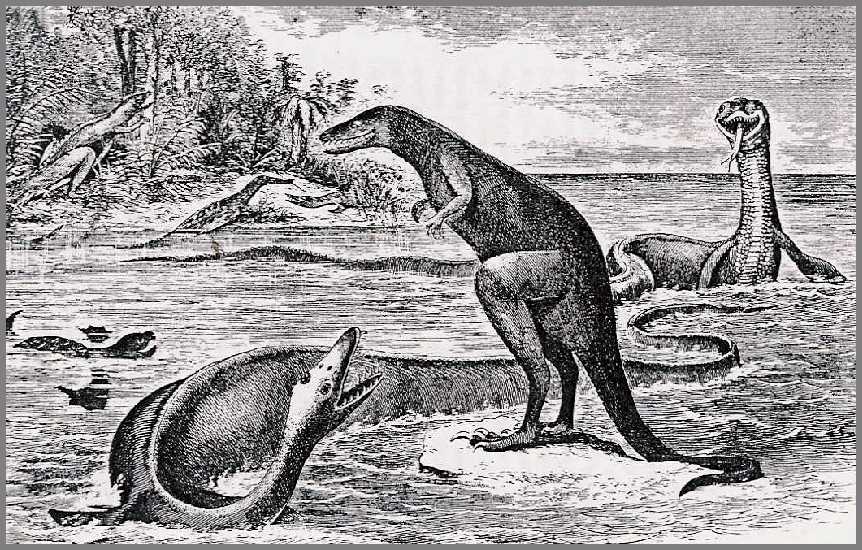

Cope, E. D., 1868. Remarks on a new large enaliosaur.
Proc. Acad. Sci. Phil., 20:92-93. (March 24, 1868)
92 PROCEEDINGS OF THE ACADEMY OF March 24th, 1868 The President, Dr. Hays, in the Chair.
Forty-members present. Prof. Cope exhibited to the Academy several fragments of a large Enaliosaurian, discovered by the Academy's correspondent at Fort Wallace, Kansas, Dr. Theoph. H. Turner. Portions of two vertebrae, brought east by Dr. LeConte from his geological survey of the Pacific Railroad route, had previously indicated to the speaker the existence of an animal related to the Plesiosaurus, and the recovery of the greater part of the reptile had confirmed this affinity. The remains consisted of over one hundred vertebræ, with numerous portions of ribs, the greater part of the pelvic and scapular arches, with two long bones somewhat like femora. Part of a muzzle, with teeth, belonged to the same animal. The species represented a genus differing in important features from Plesiosaurus and its near allies. These were the absence of diapophyses on the caudal vertebræ, and the presence of inferiorly directed plate-like parapophyses, which took the place of the usual chevron bones in the same position; also in the presence of chevron-like bones on the inferior surfaces of the cervical vertebræ; further in some details of the scapular and pelvic arches. The diapophyses of the dorsal vertebræ originated from the centrum, and not from the neural arch. In generic features it is related to the Cimoliasaurus and Brimosaurus of Leidy, so far as the latter are yet known. It differed from both of them in lacking diapophyses on the lumbar vertebræ. The general form was different from Plesiosaurus in the enormous length of the tail, and the relatively shorter cervical region. The total length of the vertebral column sent was thirty-one feet ten inches, divided as follows: caudals 18 ft. 10 in., dorsals 9 ft. 8 in., cervical 3 ft. 4 in.; adding for missing cervicals and cranium at least 2 ft. 6 in., we have a total of 34½ feet. An interval of three to four feet occurred between the cervicals and dorsals as they lay in the cliff from which they were excavated, which if, as is probable, it was occupied by vertebræ in the animal, would give a length of thirty-eight feet. The caudal vertebræ had very compressed centra, and elevated neural and haemal laminæ, and were of unusually elongate form. Neural arches everywhere on the column
[March NATURAL SCIENCES OF PHILADELPHIA 93
co-ossified. All the vertebræ considerably more constricted medially than in Brimosaurus or Cimoliasaurus, and none except cervicals with such small antero-posterior diameter as the latter possess. The general characters of the species are to be presented in a special essay. He called it Elasmosaurus platyurus Cope, from the caudal laminæ, and the great plate bones of the sternal and pelvic regions. It was a marine saurian, whose progression was more largely accomplished by its tail than by its paddles. The teeth and muzzle showed it to be an ally of Plesiosaurus. The former were cylindric, implanted in very deep alveolæ, and furnished with a very small pulp cavity. The exposed surface closely and sharply striate to the narrowly acuminate tip. The beds were argillaceous, with much gypsum; the latter mineral coating the bones. The age was Cretaceous; perhaps, according to LeConte, the upper middle. The matrix beneath the dorsal vertebræ contained remains of perhaps six species of fishes, several ctenoid, among them a known Enchodus, and a Sphyraæa, to be called Sph. carinata Cope. 1868] |